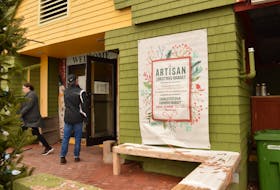CLARENVILLE, N.L. — Having to move has become ingrained with the culture of Newfoundland and Labrador over decades as local people try to carve out a way of life. They migrate to find employment to support their families, advance their careers and to be able to live where they call “home.”
The Harris Centre made a presentation to the Clarenville Rotary Club Monday, March 18, to explain findings of the eight-year-long study into commuting and its effects on the people of the province. This is referred to as employment-related geographical mobility.
Using Statistics Canada information, along with information gathered through surveys and other methods, the On the Move Partnership focused on people who move to other areas to work, including daily commutes, seasonal workers and those in mobile workplaces.
Dr. Barbara Neis laid out the specifics of their study as well as some of the effects.
She says, according to stats from 2008, interprovincial work for people earning at least 75 per cent of their income reached 12 per cent of the population. She adds the number was 11.59 per cent in the Clarenville-Isthmus region.
Financially, Neis says, this interprovincial work represents a gross figure of $1 billion in earnings in 2012.
They’ve also found the impacts of mobile working are not only financial but also social, with families using virtual parenting, grandparent child care, and other ways to adjust to the lifestyle of seasonal work or commuting.
Kelly Vodden, the Community Impacts Team Lead, went into more detail with the study, showing some of their methods of data collection and looking at the dominant themes they heard from these surveys and interviews.
Specifically, the Clarenville-Isthmus region is unique as it’s both a source and host community for mobile work.
One of the main concerns they’ve found from people in this area is the sustainability of a boom-bust pattern of the economy related to temporary projects like the Hebron oil rig build in Bull Arm. This also applies to those who work interprovincially in the oil and gas industry with a certain amount of uncertainty in particular cases.
“One of the quotes we heard is, ‘We are a boom and bust community,’” said Vodden. “So I guess the question is, can you plan for that and sustain it over time?”
This can all affect issues like available housing, with demand waxing and waning over the years of boom and bust, along with how it concerns other services like recreational facilities in towns and available healthcare.
“It’s difficult for communities to track and demand for these things according to what we’ve heard.”
However, an abundance of locally commuting workers can fuel service industries like restaurants and hotels in hub areas.
While the study has given plenty of new information that was not previously available on mobile employment, there are still remaining questions.
“We’re really just starting to understand this,” said Vodden.
She says they’re looking to get the information they’ve learned out to the public, while using what they’ve gathered as a way to plan for the future and address any problems or issues within communities in the future.
Policy recommendations for On the Move Partnership study on commuting in the province:
• Prepare and engage with mobile labour issues;
• Emphasize job readiness;
• Support functional lone-parent households;
• Manage “home” community impacts;
• Prepare “host” and “hub” communities;
• Address benefits and royalties agreements;
• Develop comprehensive information programs.
Dominant themes related to commuting culture as evidenced by local interviews:
• Concerns of sustainability;
• Effects on community dynamics;
• Effects on community engagement;
• How this affects family dynamics;
• Negative turnouts for volunteerism;
• And concerns on housing issues in the region.
Twitter: @jejparsons









